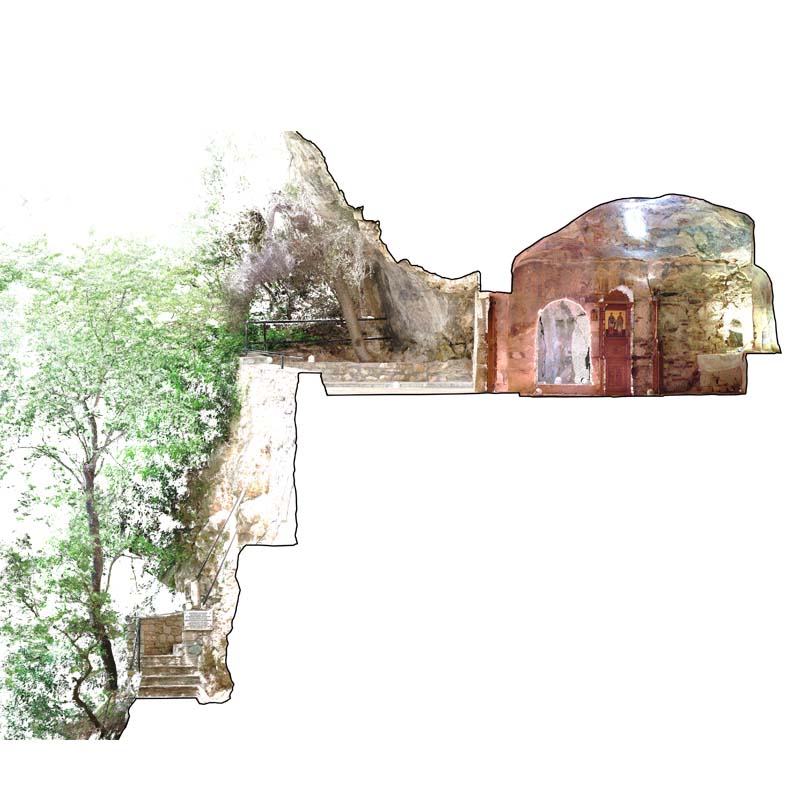

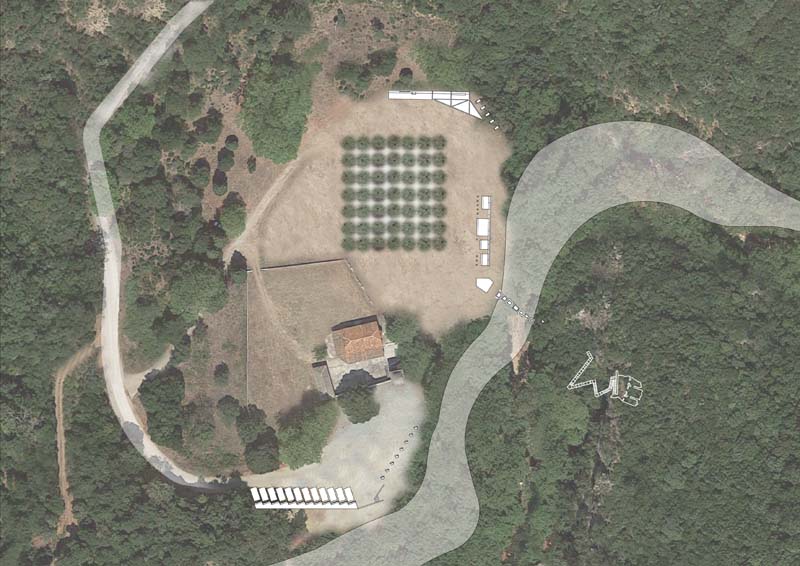

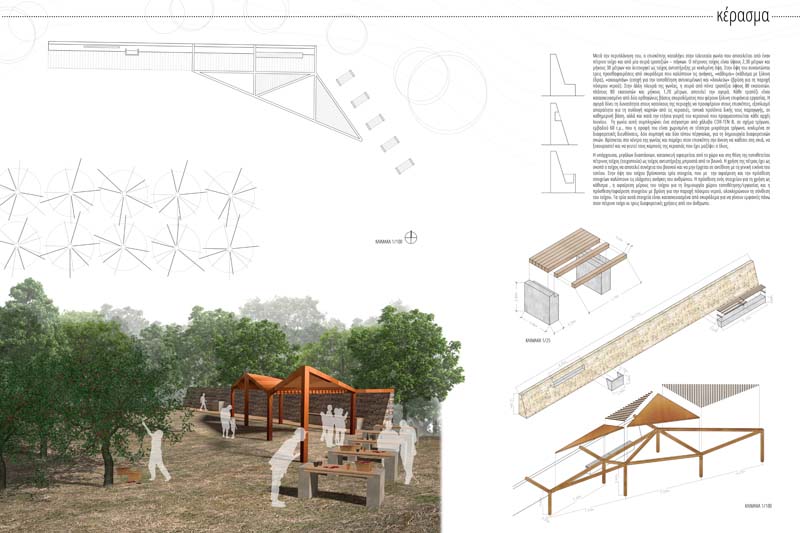

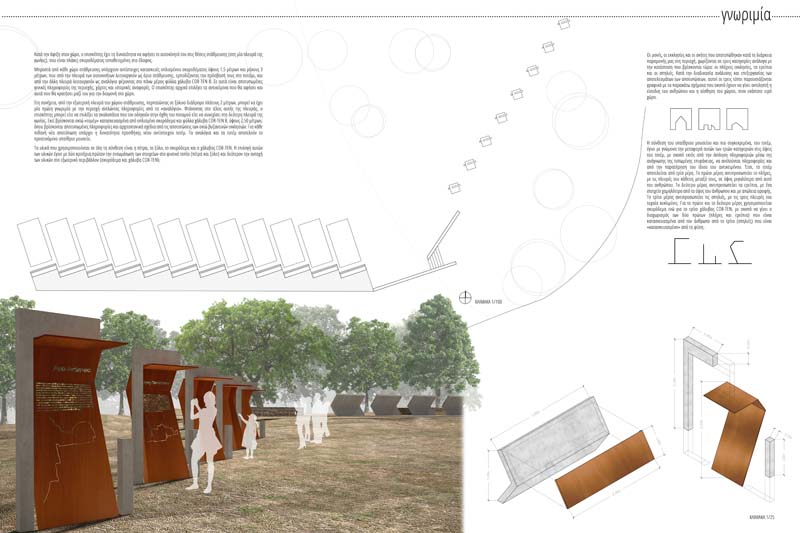

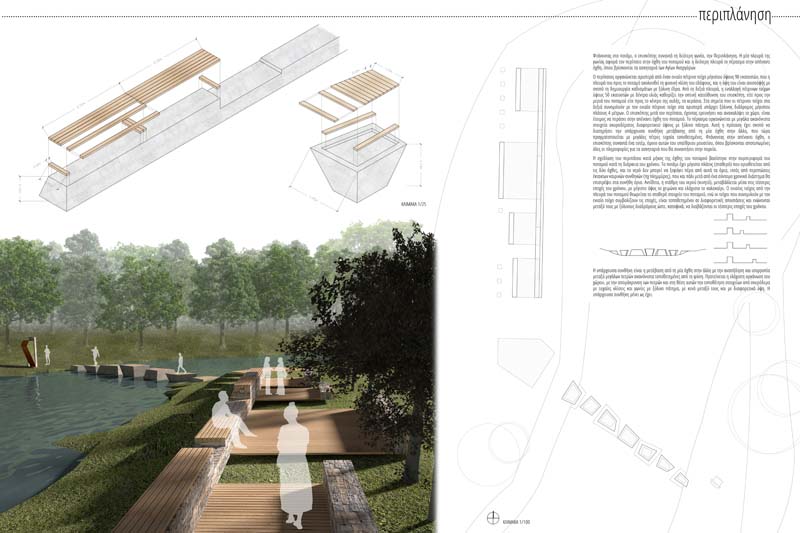

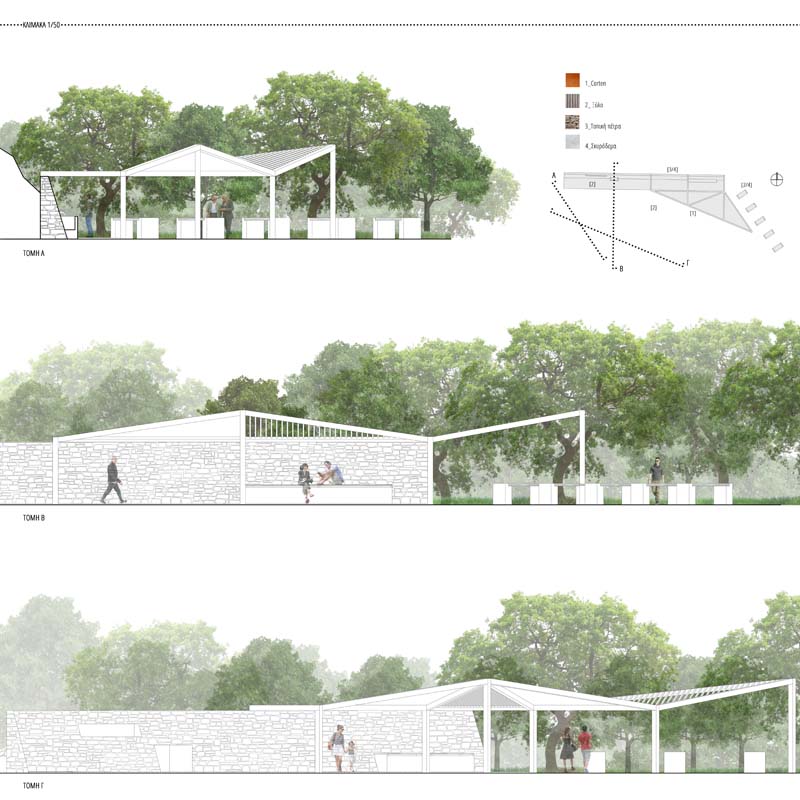

The starting point for the preparation of this thesis was the collaboration with the Department of Architecture of the University "Università degli Studi Mediterranea", in Reggio Calabria (Erasmus, the academic year 2014-2015), as I had the opportunity to participate in a workshop on making imprinting using three-dimensional digital scanner (academic year 2015-2016). The imprinting area was the Byzantine monasteries, churches and sketes in the area of Kissavos.
The thesis is structured in two parts:
The first part consists of the procedure of the imprinting which is divided in the research and the cataloging of Byzantine centers of the area, the fieldwork processing the results of imprinting and the production of the imprinting’s architectural designs.
In the second part there is a suggestion of landscape organization in one of the places that made the imprinting. The selected area, about 10 km east of Agia, consists of two parts, which are separated by a river that flows into the Agiokampos beach. Consciously, the side where lie the hermitages remains as it is, without intervention architectural and is defined as inaccessible. The other side is the subject of work. The landscape’s organization is proposed with three angles that create a "yard" in the area. Angles called Acquaintance, Wandering, and Treat. In the center of the yard placed cherry trees.
The "Acquaintance" is the arrival area. Visitors have the opportunity to learn about the area and its history and to prepare for the entrance in this place.
The "Wandering" creates space on the riverside. On one side of the corner is organized the walk along the river and on the other side there is the passage from one river bank to the other, where are the hermitages.
The "Treat" is the entrance to the center of the yard, the cherry trees. Equipment necessary for collecting fruit from the cherry trees and local produce are offered to the visitor. In the center of the angle is placed a construction that provides visitors the comfort to sit in the shade, rest and taste the cherries.
Supervisor: Papadopoulos Spiros
Reference Number: 629


In this thesis we develop an experimental form of occupation in order to create a "Eutopia", which is a fragile agreement between the residents of this region in a way that the occupation as we know it, to be converted into concentration field of collectivity and spiritual awakening. The building program is applied to an area in the city limits of Florina, a town in western Macedonia, and already has at its disposal, some buildings of architectural and cultural interest.
The existing buildings in the area, belong to the department of Plant and Animal Production, the Technical Edycational Institute and to the Local Government. The objective of this experiment is to create a neighborhood relation, maintaining the building infrastructure that already exists and adding new buildings in order to complement the needs and organizing a set of activities, resulting in harmonious coexistence and sustainable development. Additionally, the specific neighborhood will be designed and will be enhanced by focusing on autonomy in both energy and economic terms.
Supervisor: Stylidis Iordanis
Reference Number: 624


In one of the most densely populated districts of Athens, Ambelokipi, on Alexandras Avenue, one of the oldest football fields in Greece, the "Apostolos Nikolaidis" stadium, is located.Despite its historical past, its presence is currently a problem for the wider region.
The new Athens Regulatory Plan attempts to provide a viable solution for the degraded areas of the city. The stadium of Panathinaikos, along with the surrounding area, is within the redevelopment plan
The aim of our diploma project work was to understand the conditions that shape the multifaceted degradation of the area and the elements of the crisis recorded in it in order to propose our solution to the problem.
Hence, the subject of our project is to completely redesign the stadium while incorporating a new, demanding building program that could boost the economy and the social life of the area, but also become a powerful pole of attraction and growth.
The building program involves the construction of a modern, fully equipped and organized conference and exhibition center that will have all the necessary infrastructure and facilities to host small or large conferences, meetings, seminars, workshops, corporate and cultural events and exhibitions.The conference center will also offer accommodation services at the premises of a modern hotel.
The two main strategies applied at all stages of the design were to preserve the "memory" of the stadium (partly preserving or imitating forms associated with it) at the same time as integrating a large and complex program and, on the other hand, the "invasion" of green in as many as possible zones of the construction so as to achieve its integration into a larger future recovery plan for the whole region.
Supervisor: Papadopoulos Lois
Reference Number: 654


The following study presents the intervention at the abandoned settlement of Etia in Lasithi and the creation of a new building that will be the base of the INSTAP study center of East Crete and will operate with a supporting role for the needs of the settlement.
This study is divided into two major sections in order to understand the matter thoroughly and to present as much information as needed to highlight the importance of the buildings of folk architectural creation the deserve to be preserved.
In the first section, general information about the island and the folk cretan architecture is listed. Initially the geographic context and information about the history of the island at different periods of time, as well as general information about the architecture and the urban planning are presented. Then, the issue of residence in the settlements of Crete is extensively analyzed. The simple house of the people living in the countryside is analyzed in terms of typology, materials, the way of structure and morphological data. In addition, there are observations, assumptions and descriptions, which occurred after the visit and study of settlements and after interviews with (former) inhabitants and people that work at the municipalities of the region highlighted. Finally, there are examples of settlements that were abandoned and revived, after private initiative, mentioned.
The second section is about the empirical part of the research and the presentation of the proposed new building. Study and mapping of Etia was conducted, as well as study of how the INSTAP works and its actions. Then the diagrams that present the analysis of the region and the work flow until the creation of the final proposal are presented.
Supervisor: Triantafillidis Giorgos
Reference Number: 625


If we compare the interior part of the city as a the seabed, and flow of everyday life as the sea, which draws you away like a stream-wave and constantly moving you wherever its flow goes, then the roofs are the freeboards of an urban archipelago, that pop up over the city level, in which you can catch them and escape for a while.
The meaning of freeboards can be described, as the selective activation of some terraces, within the dense urban fabric, through the multiple typologies proposed as an initial impulse for the occupation of this new territory of this much needed air, defined by the ridge, and therefore the occupation of the Attic Basin.
Typologies are placed in rooftop chambers that meet specific requirements, following a specific strategy before we characterize them as freeboards. Typologies themselves are classified according to their program on the following categories: geomorphology, transport, roof-chamber, viewing, interactivity, holidaying and comment. They are also accompanied by characteristics such as: cover area, basic dimensions, main materials, indicative number of people, number of parts, seasonality and finally their need for water and electricity.
Such an intention cannot be applied at the narrow margins of a local area, because urban regions such as the one of Athens show similar characteristics and could therefore support a common, transportable, project. As a model for the implementation of the idea, the area of Neapolis, was selected because it is a piece of land with the urban geology that we are looking for.
Finally, cannot be determined with accuracy on how the city will embrace the freeboards, as we are talking about a completely unknown action, followed by an equally unknown reaction. In general, the character of the project focuses on the intent and the approach of the top side, rather than on its unitary solution.For this reason it leaves open pathways, to the majority of its parts, to every citizen-walker, supporter-dissident, spectator-voyeur.
Supervisors: Gavrilou Evelyn, Paniyiris Costis
Reference Number: 631


The major purpose of this thesis is the attempt to study the evolutionary route of the peninsula of the Greek island Andros and particularly its capital, Chora, in a timeline from the 13th to 21st century. This attempt will contribute to the understanding of the importance of Choras historical value and in which way its social and cultural components defined the crucial role, not only in a spatial, but in a social level too.
Andros is the second largest island of a group of islands named Kyklades, and Chora is located in the southeast part of Andros. Through the 13th to the 21st century, Chora developed numerous periods of cultural and economic prosperity, which are captured in various buildings which represent the traces of the people in the landscape.
Chora avoided to follow the standardized patterns of touristic prosperity and maintained its urban character, full of cultural wealth, which captured in its architectural style.
On the other hand, Chora seemed to avoid any interference of refine in its architectural style, like the one that its society had acculturated through the years. The selection of Chora was the result of its cultural identity which tries to preserve and promote the sector of tourism, even now, in a period of dormancy.
In the first part, the major issues of lack of development, social coherence, and environmental degradation are presented and putted in categories. Secondly, a selection of specific places of Chora is presented. Those places determined a crucial role in Choras social and cultural presence and our proposals for further interference in these places is presented.
The purpose of our proposal is the improvement of the present infrastructure, the harmonic structure of its usage, and finally, the urban planning and cultural refreshment of those places we selected.
Supervisor: Trova Vasso
Reference Number: 615


K. a. a. s. (Communal colony of urban cohabitation) is a project that suggests the conversion of an old department store building into a collective housing hub.
The current model of urban housing in Greece is amid a crisis. As a result, alternative ways of inhabiting apartments have emerged, such as sharing or subleasing a flat. Having defined the problems of living in personal apartments, we tried to develop an example that solves the aforementioned problems but also suggests a new and different model of urban dwelling, based on the following characteristics; augmented shared spaces opposed to smaller personal space, activation of the entirety of the given space, the inhabitants are able to form their common environment according to their needs, simultaneous use of the whole infrastructure by everyone.
K. a. a. s. is not only about housing though. It enriches and diversifies public space around the area it occupies and is hoping to set the scene for an alternative, bottom-up development of a neglected neighborhood of Volos.
The goal of this project is to provoke the sense of equality, cooperation and solidarity between the inhabitants so that they form a new model of social life that opposes to the current individuality and alienation.
Supervisor: Mitroulias Giorgos
Reference Number: 653


The thesis focuses on the restoration of the houses that belonged to the famous poet’s family and the construction of housing for accommodation in the area of Agios Stefanos, Monemvasia.
The mansion of the family that was donated to charity will now have a cultural function. In the main building there will be a small collection of books where the visitors will be able to read while relaxing in front of the great view of Monemvasia and the blue Aegean Sea. In the basement of the same house, lessons of photography will be given to the visitors. In the adjacent building, which will also be renovated, an exhibition space will be presented.
One of the most important goals of the thesis is to exploit the ground of the area to achieve a great view in every part of the project. In order to accomplish that, most of the buildings are going to be immersed in the ground. Privacy is on high importance to the guests while a long walk is designed and sometimes passes between the residency rooms.
The element of water fountains is of high importance and therefore is going to be maintained as existed on the ground. The central square is located around the largest cistern and many paths start or pass through it. This maintains the concept of the movement around the square.
The olive trees existing in the area will be protected and brought forward and wine trees will be allowed to grow so that a small production of wine can be produced and enjoyed by the guests.
Supervisor: Triantafillidis Giorgos
Reference Number: 635

